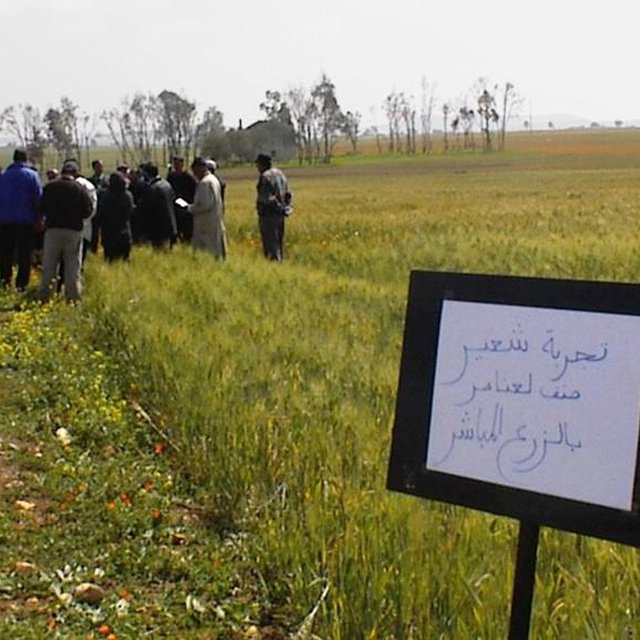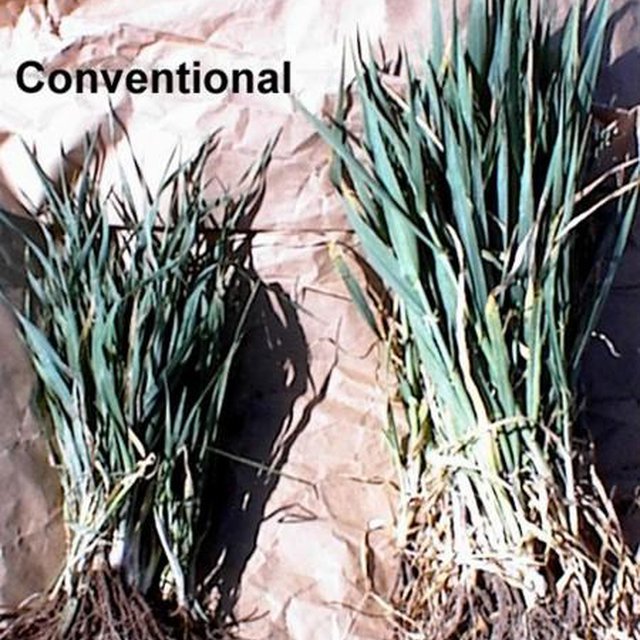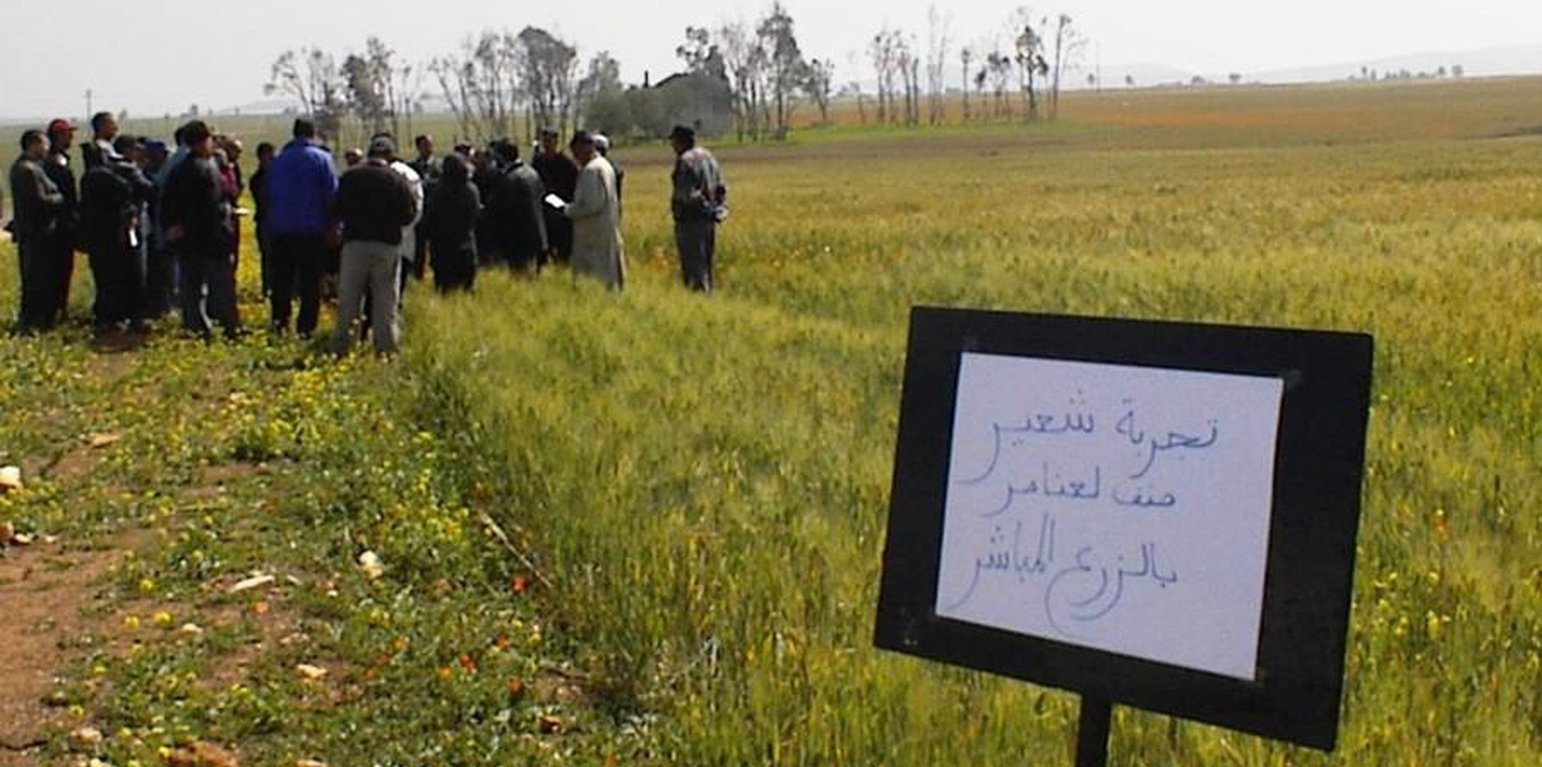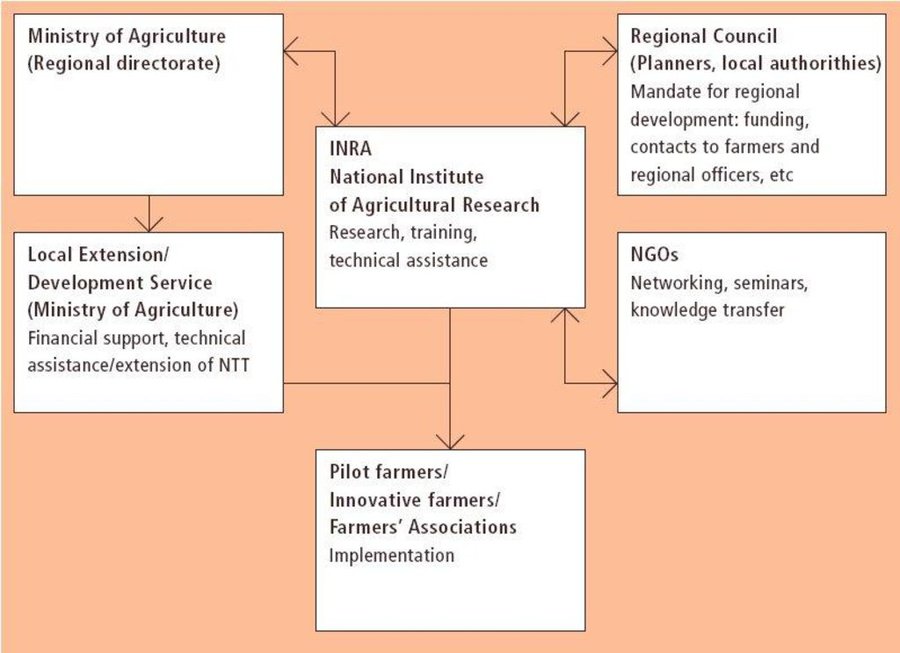Applied research and knowledge transfer
(Морокко)
Тодорхойлолт
Innovative, cross-disciplinary community-based approach for development and transfer of no-till technology at the farm level.
Aims / objectives: After 15 years of on-station research at the National Institute of Agricultural Research (INRA), testing and evaluation of no-till technology (NTT) at farm level started in 1997 with three pilot farmers. Recently two new projects were established to promote the introduction and adoption of NTT, in collaboration with the regional council and extension service of the Ministry of Agriculture (MoA). Fourteen pilot farmers are now involved in NTT. The overall purpose is to promote no-till technology to restore soils, improve production, mitigate drought, increase wealth and strengthen farmers??? organisations. NTT has been shown to be socially, economically and ecologically adapted to the local conditions. The approach has three stages: (1) Initiation: this includes basic research, strategic research and applied research; (2) Consolidation: planning is followed by detailed evaluation of technology adoption on farmers' fields; (3) Maturity: this involves the acceptance/spread of NTT with an increased number of farmers in the future.
Methods: INRA carries out research, information dissemination, gives training to technicians and farmers, and provides both technical assistance and monitoring. The regional council was convinced by the technology and now financially supports research activities, drill manufacture and extension of NTT. It also facilitates contacts with decision makers and farmers, and carries out evaluations. MoA development and extension services provide financial support, advice, technical assistance, and logistical support to farmers: they help to make the drills available. NGOs are engaged in the development of local/regional networks and farmers associations, as well as in funding and providing incentives. Farmers themselves are involved in the implementation, evaluation and dissemination of NTT. Participation, cross-discipline and bottom-up planning are key elements of the approach. Methods for implementation include long-term community on-farm trials, on-site training and information exchange, participation of stakeholders, information dissemination tools, and multi-directional knowledge flow. These are supplemented by intensive measurement/monitoring schemes, establishment of local/regional networks and farmers' association creation. On-the-job training is also provided.
Байршил

Байршил: Chaouia/Ouardigha, Морокко
Сонгосон байршлуудын газарзүйн холболт
Эхлэх огноо: 1997
Төгсөх жил: тодорхойгүй
Арга барилын төрөл
-
уламжлалт / уугуул
-
Сүүлийн үеийн орон нутгийн санаачлага / шинэчлэл
-
төсөл / хөтөлбөр дээр үндэслэсэн

No-till field day in Benahmed region. The sign says: Trial with barley, direct seeding

Barley samples from on-farm plots at Khourigba, showing improved growth under no-till technology compared with conventional farming.
Арга барилын зорилго ба эерэг нөлөө
Арга барилын үндсэн зорилго, зорилт
The Approach focused mainly on SLM with other activities
- spread the no-till technology: thereby enhancing soil productivity and reducing susceptibility to land degradation. - develop the production of no-till drill machinery. - generally: to ameliorate the living conditions of rural people through enhancing expertise, capacities and knowledge of farmers in managing their soils and crops
The SLM Approach addressed the following problems: - previous absence of an integrated research and extension programme. - lack of technical options in a harsh and risky environment. - underlying problems of land degradation and drought periods
Тухайн Арга барилын хүрээнд нэвтрүүлсэн Технологийг хэрэгжүүлэхэд дэмжлэг болох нөхцлүүд
Тухайн Арга барилын хүрээнд нэвтрүүлсэн Технологийг хэрэгжүүлэхэд хүндрэл учруулах нөхцлүүд
-
Нийгэм / соёл / шашны хэм хэмжээ, үнэт зүйлс: Over-reliance on traditions in soil management; attitudes of farmers towards conventional tillage need challenging through information about alternatives.
Treatment through the SLM Approach: Training, video conferences, travelling workshops, etc.
-
Санхүүгийн нөөц, үйлчилгээний хүртээмж / боломж: Lack of specific funds, credit, loans for investment in new machinery
Treatment through the SLM Approach: Prioritise funds for no-tillage development
-
Бүтэц зохион байгуулалт: Extension service are not well incorporated in the approach due to lack of knowledge/information on no-tillage
Treatment through the SLM Approach: Special Training program; change of institutional thinking upon no-tillage systems
-
Хууль, эрхзүйн хүрээ (газар эзэмшил, газар, ус ашиглах эрх): lack of SWC-relatedl laws
Treatment through the SLM Approach: Recommendations on laws to cover SWC technologies.
The existing land ownership, land use rights / water rights moderately hindered the approach implementation small size of field requires integration of farmers for using no-till drill and other equipment
-
ГТМ-ийн талаарх мэдлэг, техникийн дэмжлэг авах боломж: Lack of adapted machinery
Treatment through the SLM Approach: Promotion of no-till drill industry in Morocco
Талуудын оролцоо ба үүрэг
Арга барилд оролцогч талууд болон тэдгээрийн үүрэг
| Ямар оролцогч талууд / хэрэгжүүлэгч байгууллагууд арга барилд оролцож байсан бэ? |
Оролцогч талуудыг тодорхойлно уу |
Оролцогч талуудын үүргийг тайлбарлана уу |
| Орон нутгийн газар ашиглагч / орон нутгийн иргэд |
|
|
| олон нийтэд түшиглэсэн байгууллагууд |
Existing groups of land users |
|
| ГТМ-ийн мэргэжилтэн/ хөдөө аж ахуйн зөвлөх |
|
|
| Засгийн газар (шийдвэр гаргагч, төлөвлөгч) |
INRA |
|
Арга барилын янз бүрийн үе шатанд орон нутгийн газар ашиглагчид / бүлгүүдийг татан оролцуулах
үгүй
идэвхигүй
Гадаад дэмжлэг
интерактив
өөрийн хүчийг нэгтгэсэн
санаачлага/идэвхжүүлэлт
Mainly:public meetings; partly: workshops/seminars; open days
Төлөвлөгөө
Mainly: workshops/seminars; partly: public meetings
Хэрэгжилт
Mainly: responsibility for minor steps; partly: casual labour
Мониторинг/ үнэлгээ
Mainly: interviews/questionnaires; partly: measurements/observations; field observations
Research
on-farm; demonstration plots
Арга барил хэрэгжүүлэх бүдүүвч
Institutional framework: Stakeholders and their roles: cross-disciplinary linkages between INRA, collaborating institutions and farmers.
ГТМ-ийн технологи сонгох шийдвэр гаргах явц
Шийдвэр гаргасан этгээд
-
Газар ашиглагч дангаараа (өөрийн санаачлага)
-
ГТМ-ийн мэргэжилтнүүдийн дэмжлэгтэйгээр, голчлон газар ашиглагчид
-
оролцооны зарчмын хэсэг болох бүх холбогдох талууд
-
голдуу ГТМ-ийн мэргэжилтнүүд, газар ашиглагчидтай зөвлөлдсөний үндсэн дээр
-
ГТМ-ийн мэргэжилтэн дангаараа
-
улс төрчид / удирдагчид
Шийдвэр гаргах үндэслэл нь
-
ГТМ-ийн мэдлэгийг баримтжуулалтын үнэлгээ (нотолгоонд суурилсан шийдвэр гаргах)
-
Судалгааны үр дүн, ололтууд
-
Хувь хүний туршлага ба санал бодол (баримтжуулаагүй)
Техникийн туслалцаа, чадавхи бий болгох болон мэдлэгийн менежмент
Дараах үйл ажиллагаа эсвэл үйлчилгээ нь арга барилын нэг хэсэг болсон
-
Чадавхи бэхжүүлэх/сургалт
-
Зөвлөх үйлчилгээ
-
Институцийг бэхжүүлэх (байгууллагын хөгжил)
-
Мониторинг ба үнэлгээ
-
Судалгаа
Чадавхи бэхжүүлэх / сургалт
Дараах сонирхогч талуудад сургалт хийсэн
-
Газар ашиглагчид
-
хээрийн ажилтан / зөвлөх
-
extensionists/trainers, politicians/decision makers, planners
Сургалтын хэлбэр
-
Ажил дээр
-
фермерээс -фермер
-
үзүүлэнгийн талбай
-
Олон нийтийн уулзалт
-
курс дамжаа
Хамарсан сэдэв
no-tillage system, weed control, machinery, cropping systems, crop variety
Зөвлөх үйлчилгээ
Зөвлөх үйлчилгээ үзүүлсэн
-
Газар ашиглагчийн талбай дээр
-
Тогтмол төвд
Key elements: Participation of extension agents and farmers / observations (on the crop, weeds, disease, seeding condition, yield components), On-job training / open days (field days to make farmers and extension discuss questions / remarks regarding no till technology, Monitoring/Participatory; 1) Advisory service was carried out through: government's existing extension system 2) Advisory service was carried out through: government's existing extension system; Extension staff: mainly government employees 3) Target groups for extension: land users; Activities: demonstration, field days, traveling workshops
Advisory service is inadequate to ensure the continuation of land conservation activities; Extension Agents need training
Институцийг бэхжүүлэх
Институци бэхжисэн / бий болсон
-
Үгүй
-
Тийм, бага
-
Тийм, дунд зэрэг
-
Тийм, маш их
дараах түвшинд
-
Орон нутгийн
-
Бүс нутгийн
-
Үндэсний
Байгууллага, үүрэг, хариуцлага, гишүүд зэргийг тодорхойлно уу.
Дэмжлэгийн төрөл
-
Санхүүгийн
-
чадавхи бэхжүүлэх / сургалт
-
Тоног төхөөрөмж
Дэлгэрэнгүй мэдээлэл
Мониторинг ба үнэлгээ
Bio-physical aspects were regular monitored by 0 through measurements
Technical aspects were regular monitored by 0 through measurements
Socio-cultural aspects were ad hoc monitored by 0 through observations
Economic / production aspects were regular monitored by 0 through measurements;
Area treated aspects were ad hoc monitored by 0 through observations
No. of land users involved aspects were regular monitored by 0 through measurements
Management of Approach aspects were ad hoc monitored by 0 through observations;
There were no changes in the Approach as a result of monitoring and evaluation: The evaluation is still in process: thus too early to state what changes are likely.
Судалгаа
Судалгаа нь дараах сэдвийг хамарсан
-
Социологи
-
Эдийн засаг/ зах зээл
-
Экологи
-
Технологи
-
agronomy
crop performance, soil analysis, no-till drill design and evaluation, socio-economic indexes of NTT.
Research was carried out both on station and on-farm
Санхүүжилт болон хөндлөнгийн материаллаг дэмжлэг
ГТМ-ийн бүрэлдэхүүн хэсгийн жилийн төсөв ам.доллараар
-
< 2,000
-
2,000-10,000
-
10,000-100,000
-
100,000-1,000,000
-
> 1,000,000
Precise annual budget: тодорхойгүй
Approach costs were met by the following donors: government (national - INRA/Ministry): 80.0%; local community / land user(s) (Regional Council): 20.0%
Газар ашиглагч нарт дараах урамшуулал, үйлчилгээг үзүүлсэн
-
Газар ашиглагчдад санхүүгийн / материаллаг дэмжлэг үзүүлсэн
-
Тодорхой хөрөнгө оруулалтанд нөхөн олговор олгох
-
Кредит
-
Бусад урамшуулал, хэрэгсэл
Газар ашиглагчдад санхүүгийн болон материаллаг дэмжлэг үзүүлэх
хэсэгчлэн санхүүждэг
Бүрэн санхүүждэг
Тоног төхөөрөмж: машин төхөөрөмж
Хөдөө аж ахуй: Үр, үрсэлгээ
Хөдөө аж ахуй: Үр, үрсэлгээ: Бордоо
Газар ашиглагчаас гаргасан хөдөлмөр хүчний зардал
-
сайн дурын
-
хоол хүнсээр ажилладаг
-
бэлэн мөнгөөр төлдөг
-
бусад материаллаг дэмжлэгээр шагнагдсан
Зээл
-
Нөхцөл байдал: repayment conditions: To promote the acceptance of the technology, farmers receive a 50% subsidy on the purchase price of the no-till drill (as is the general case for all types of drills)..
-
Зээлийн үйлчилгээ үзүүлэгчид: тодорхойгүй
-
Зээлийн үйлчилгээ хүлээн авагч: тодорхойгүй
Нөлөөллийн дүн шинжилгээ ба дүгнэлт
Арга барилын үр нөлөө
Үгүй
Тийм, бага зэрэг
Тийм, зарим
Тийм, их
Арга барил нь ГТМ-ийн технологийг хэрэгжүүлж, хадгалахад газар ашиглагчдад тусласан уу?
Better use of the rainwater stored in the soil by crops leads to improvement of soil and water management: increase in soil organic matter has multiple benefits.
Арга барил нь ГТМ-ийн технологийг хэрэгжүүлэхэд саад учруулсан газрын эзэмшил / ашиглах эрхийг сайжруулахад чиглэсэн үү?
The land is a private property and can not be affected by no-tillage but with no-tillage farmers can rent or buy new lands for adoption of more no-tillage.
Did other land users / projects adopt the Approach?
This no-till system can now be considered for several different agroecological situations where a similar approach can be applied (e.g. flood control project, agro-forestry program, soil restoration project, etc.).
Газар ашиглагчид ГТМ хэрэгжүүлэх болсон үндсэн шалтгаан
Арга барилын хүрээнд хэрэгжүүлсэн үйл ажиллагааны тогтвортой байдал
Газар ашиглагчид арга барилаар дамжуулан хэрэгжүүлсэн арга хэмжээг тогтвортой үргэлжлүүлж чадах уу (гадны дэмжлэггүйгээр)?
Progress can continue to be made, assuming that training, subsidised drills, and the creation of farmers' organisations all persist.
Дүгнэлт, сургамж
Давуу тал: газар ашиглагчийн бодлоор
-
Adaptability to farmers needs/constraints (How to sustain/ enhance this strength: Include integration of livestock and crops. This should be helpful to pursue in the approach)
-
Farmer's decisions, opinions, critics (How to sustain/ enhance this strength: Bottom-up maintained (gradually))
-
Incentives make it possible for land users to experiment with a new cultivation system (How to sustain/ enhance this strength: Diversification of incentives: eg reduction in seed prices and herbicides for NTT farmers; award - NTT best producers; reduction in interest rates for NTT farmers (for credits or loans); special NTT training courses.)
Давуу тал: эмхэтгэгч эсвэл бусад мэдээлэл өгсөн хүмүүсийн бодлоор
-
The NTT project has integrated several institutions -which is unique in Morocco. Now research, extension, community and farmers are working together towards the same objective (How to sustain/ enhance this strength: Further develop, refine and spread NTT)
-
NGOs development: the association of NTT farmers and environmental clubs are important for spreading NTT and for re-enforcing the importance of NTT amongst government officers and decision makers (How to sustain/ enhance this strength: special NGOs should be encouraged to respect soils, nature, environment)
-
Cross-discipline: involving land users, research and extension agents has helped in building up an approach suitable for the local conditions. (How to sustain/ enhance this strength: The working teams received also incentives and recognictions)
-
research connected to extension (How to sustain/ enhance this strength: research should be developed to get continuous measurements/information and to search new indexes and means)
-
Progressive implementation of a 'bottom-up' approach; integration of farmers' decisions, opinions and criticisms (How to sustain/ enhance this strength: Farmers and their association are involved gradually in the approach and their critics, comments, feedbacks respected)
Сул тал/ дутагдал / эрсдэл: газар ашиглагчийн бодлоордаван туулах боломжууд
-
Information availability: up to now information and communication on NTT is scarce
intensify training of trainees
-
In some situations (farmers with very low incomes), the need for external inputs such as herbicides, seeds, fertilizers and drills may retard implementation of NTT
Incentives should be maintained for a short period and supplemented by credit systems.
Сул тал/ дутагдал / эрсдэл: эмхэтгэгч эсвэл бусад мэдээлэл өгсөн хүмүүсийн бодлоордаван туулах боломжууд
-
Direct incentives: there is always a risk that when eliminating these incentives, farmers will abandon NTT
Eliminate incentives gradually and replace with loans and credits.
-
The programme's duration is currently too short to overcome resistance (to new technology adoption) and to address economic constraints of farmers
A long term programme is needed to increase acceptance among farmers.
Суурь мэдээлэлүүд
Хянагч
-
David Streiff
-
Alexandra Gavilano
-
Deborah Niggli
Баримтжуулсан огноо: 19 1-р сар 2009
Сүүлийн шинэчлэл: 04 4-р сар 2018
Мэдээлэл өгсөн хүн
-
Rachid Mrabet (mrabet_rachid@hotmail.com) - ГТМ мэргэжилтэн
WOCAT мэдээллийн сан дахь бүрэн тодорхойлолт
Баримтжуулалтыг зохион байгуулсан
Байгууллага
- Institut National de la Recherche Agronomique Morocco (INRA-Morocco) - Морокко
Төсөл
- Book project: where the land is greener - Case Studies and Analysis of Soil and Water Conservation Initiatives Worldwide (where the land is greener)
Гол сурвалж баримт сэлт
-
Wall et al, 2002, Institutional aspects of conservation agriculture, International workshop on conservation agriculture for sustainable wheat production, 14-18, october 2002, Tastikent, Usbekistan: p.wall@cgiar.org
-
Segry, L.; Bouzinac, S and Pieri, C. 1991: An Approach to the development of sustainable farming systems. World echnical papaer N-2, ISBRAM proceedings 1991:







